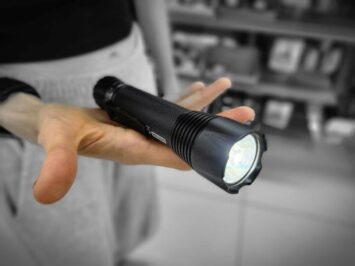Ice fishing is a whole new world compared to your freshwater fishing scene, but it is also one of the most fun fishing experiences ever – given it is over ice. This is why so many anglers take holidays or spend their entire winter somewhere that offers this fun sport.
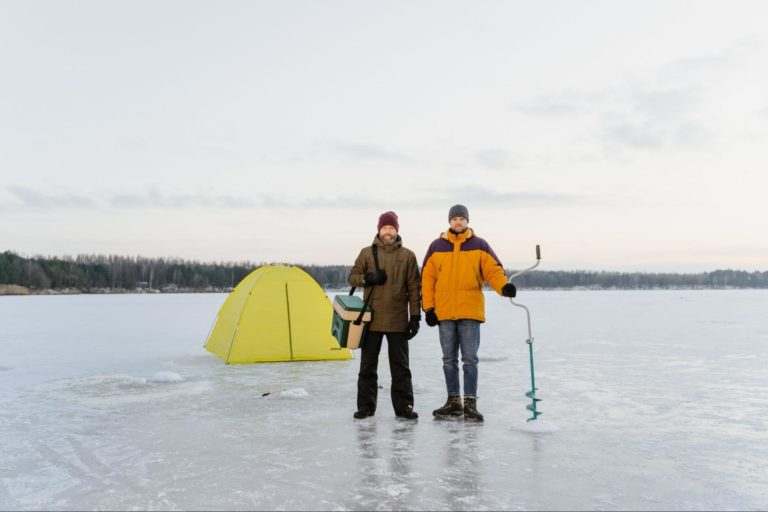
For those who may be unfamiliar with the lingo, an angler is a word used to describe a person who fishes with a rod and line. The term angler was coined in the 1500s and continues to be used today as a reference to different types of fishermen.
From spending time in the cold winter air to being rewarded with a fish dinner. Ice fishing is a sport that can be very relaxing and exciting. So why not ensure that you’re prepared for your first ice fishing experience?
Quick Navigation
ToggleEssential Ice Fishing Gear
Ice fishing gear differs from conventional freshwater fishing gear. Ice fishing gear requires thick and hardy gear that complies with harsh weather and fish handling in the cold.
Fishing Float Suit
Before setting out to ice fish make sure that you have a float suit for ice fishing. These ice fishing suits typically have two layers, a jacket, and an ice fishing bib. These suits are highly water-resistant and do not absorb water; therefore, you’ll be safe from the weather and from the chance of drowning if you fall in the water.
Ice Fishing Rods, Reels, and Lines
Beginner anglers should opt for a rod and reel combo. These combo packs are often cheaper than buying the two separately and ensure that your rod and reel are compatible.
Ice fishing lines have a special coating that prevents freezing, giving them an advantage over a regular line. Ice fishing lines are also low visibility, making them the most superior option. Ensure that the material is either mono, braided, or fluorocarbon to get the best results.
Ice fishing Boots, Gloves, and Face Masks
Unless you’re a big fan of frostbite, ice fishing boots are a must, no questions asked. Your boots should be comfortable, warm, and waterproof. It is important to note that all boots should have creepers added on. Creepers are metal spikes that are mounted to the sole of your boot to prevent from skidding on the ice.
Neoprene water-proof gloves are also essential to prevent frostbite. These gloves will have holes on the thumb and index finger so you can continue to tie your knots without having to remove your gloves.
Protect your face from wind, cold temperatures, and frostbite with a face mask. Face masks are typically thick and made of fleece. When wearing a face mask, ensure that your vitals, consisting of the nose and ears are covered to stay warm. A beanie or warm hat could also be a nice addition.
Additional Ice Fishing Accessories
Additional materials that every angler should have in their backpack are ice tools, a chair, food, a first-aid kit, and optional electronics (GPS, fish finder, tip-ups).
For thicker ice, ice fishing augers are powerful and resemble giant corkscrews. The only downside is that these tools can be a bit heavier.
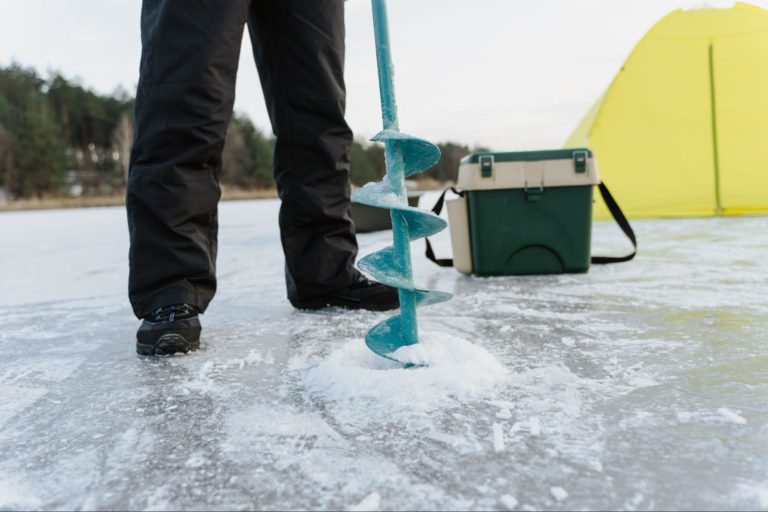
Ice fishing chisels are long blades that are lightweight and perfect for thinner ice. You can also get a slush scoop to dig out excess ice in your hole.
Fish finders are essential to identify healthy vegetation. Fish finders resemble GPS and use SONAR technology to locate fish. They even give an analysis of seabed and water depth. This is all done through the transmission of ultrasonic waves and reflection reception.
The fish finder will both identify fish and let you know if an area is viable to carve a hole. These tools are great to avoid wasting your time out in the cold.
GPS can be great for marking a hotspot fishing location. The GPS will remember the location and you can easily return the following season.
Tip-ups are great for slow fishing days or for catching multiple fish. Tip-ups allow you to set up to 12 rods and increase your likelihood of making a catch; however, tip-ups can be overwhelming on busy days!
Ice fishing Safety
With ice fishing comes great risks such as getting lost, frostbite, and falling into ice. In reality, ice fishing is never 100% safe. To ensure your safety, follow the following safety protocols:
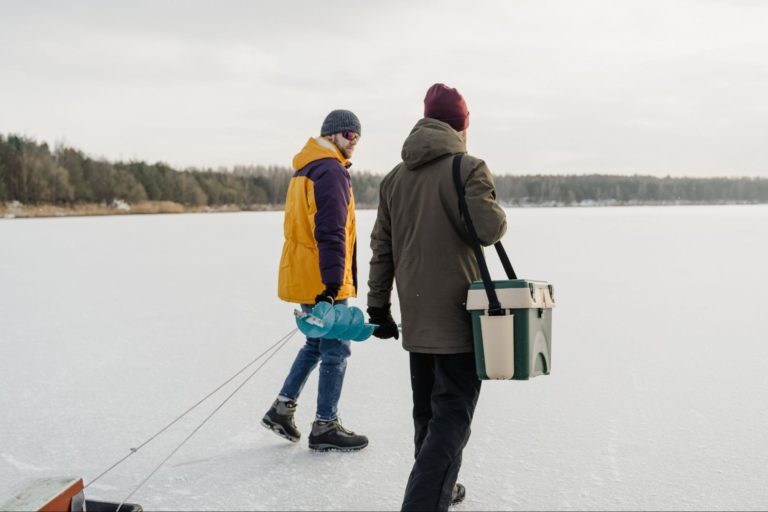
- Share your fishing plans. Make sure someone knows where you’re going, the duration of your trip, and the exact location.
- Bring someone with you. Bringing someone with you gives you an extra set of hands, eyes, and ears in the event of an emergency.
- Leave before dark
- Follow the ice thickness guidelines:
- 2” or less – Stay off the ice
- 4” – Ice fish on foot
- 5” – ATV safe
- 8” – 12” – Car safe
- 12” – 15” – Medium truck safe
If you don’t know the thickness of the ice, stay off and ask a local if they know.
Additional ice fishing safety includes carrying rescue claws, a throw rope, and a power bank.
Drilling Location and Holes
Look for areas that have healthy vegetation with your fish finder, you’ll want to pull up nice healthy weeds. Areas with healthy weeds will have more oxygen, more fish, and healthier fish. If you pull up dead weeds, there are either less healthy fish or no fish in the area.
Target lakes with good fish populations, ponds deeper than 10 feet, and ice fishing tournament locations.
Safety Precautions
Avoid rivers, streams, and spring-fed lakes and ponds. Rivers and streams tend to have faster water and will not freeze fully to support human weight. Spring-fed lakes and ponds also consist of warmer temperatures; therefore, they pose a safety hazard.
To drill an ice fishing hole, place the blade on the ice and turn the handle to drill your hole.
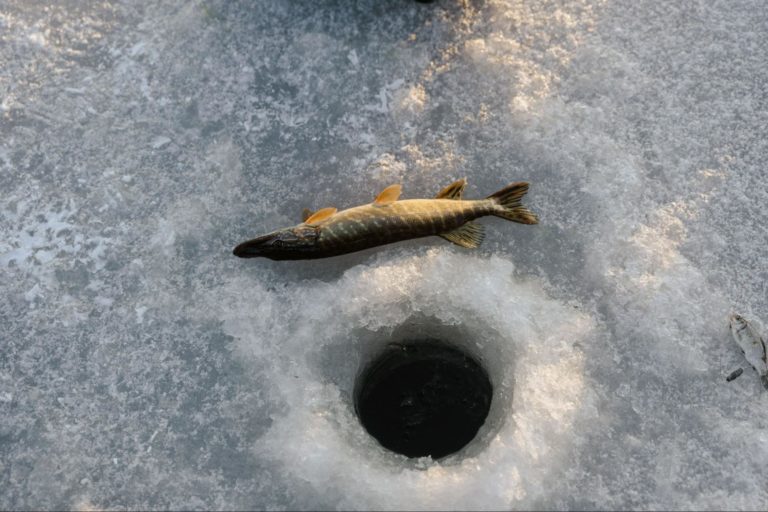
If you’re using a power auger, pick the size that matches the type of fish you are after. If you are aiming to catch a small fish, a 6-inch hole will do. If you are aiming to catch a large fish, a 10-inch hole is best.
Lures and Bait
Jigging lures are great for calling in big fish from afar. These lures do great in stained water and are great for night fishing. The most popular options include the Rapala jigging rap, moonshine shiver minnow, and the northland puppet minnow.
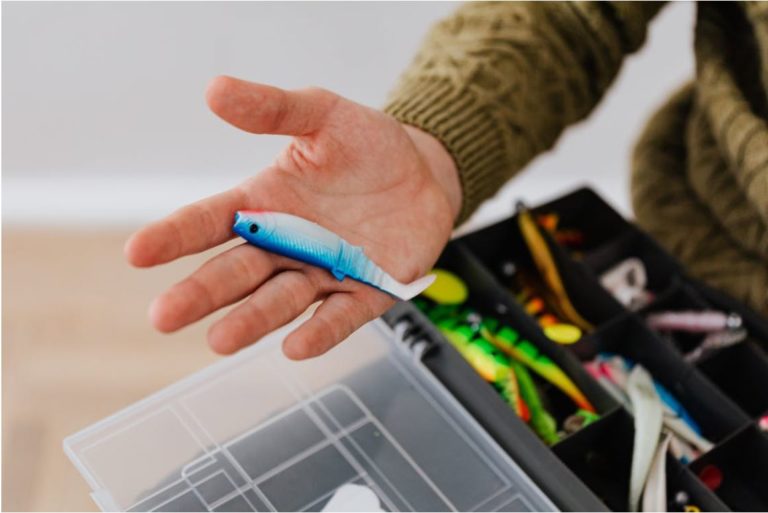
Ideal Ice Fishing Bait
Ideal ice fishing bait includes minnows, maggots, grubs, or wax worms. Fish tend to prefer moving targets so opting for one of these options will increase your likelihood of catching a fish.
Average Fishing Time and Duration
Unless you’re waiting on a pressure drop or afternoon bite, spending an hour at a spot is a good rule of thumb. Although, it can be hard to tell depending on the scenario and multiple factors.
A flasher can be a great investment if you’re trying to see if there are any fish in the area. Flashers differ from fish finders in terms of how they are used. Fish finders do well with movement while flashers are good for stationary fishing.
Flashers use sonar technology and resemble a GPS in appearance. Flashers are great for monitoring fish activity and water depth.
If you have a flasher and identify fish in the area, changing bait presentation rather than spots is a good idea.
Conclusion
Remember to brush up on safety and fishing regulations in the area you will be fishing in before your trip. Ensure that you have all the necessary gear to stay warm and to effectively carry out your first ice fishing adventure. Happy fishing!
